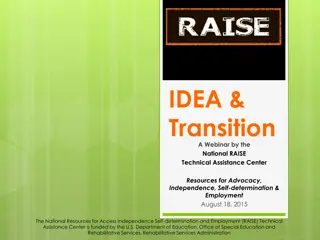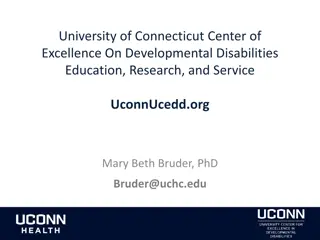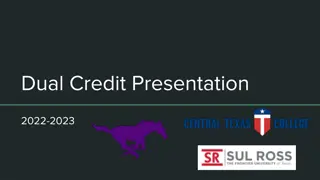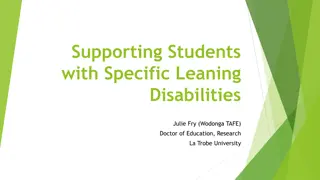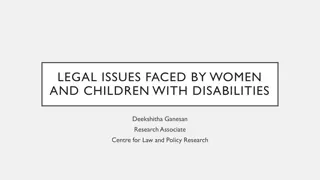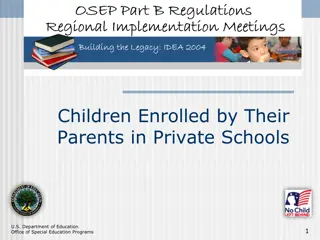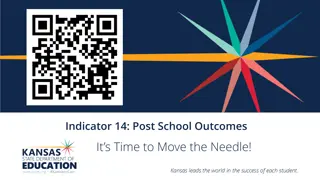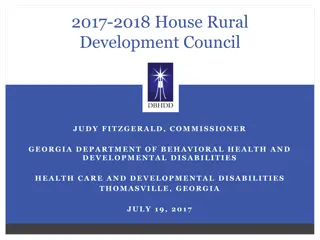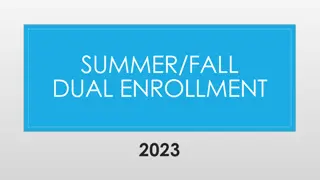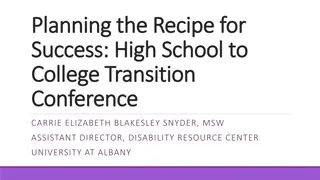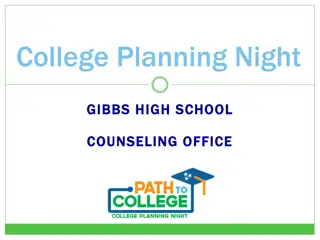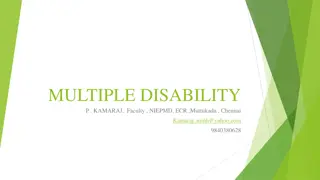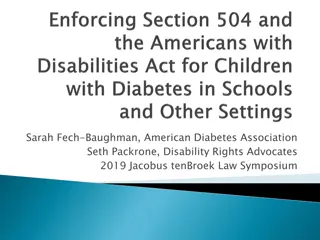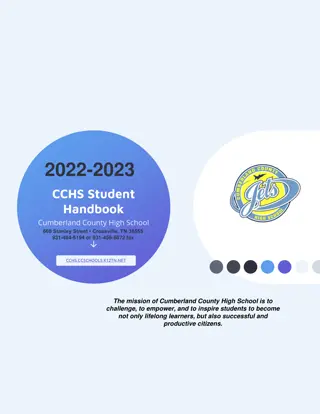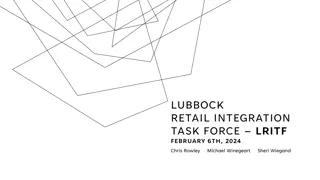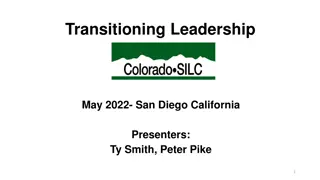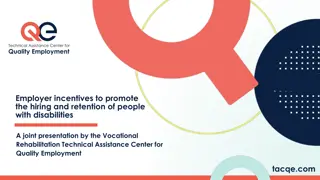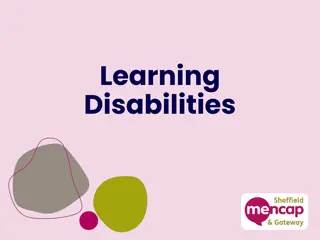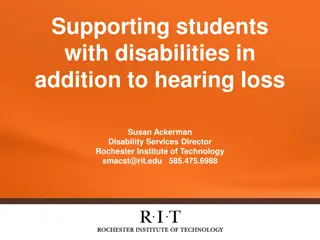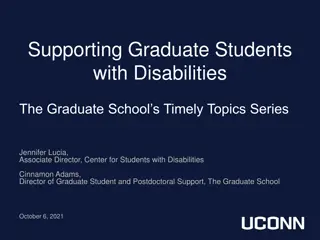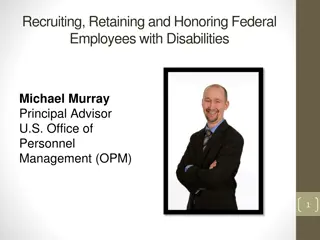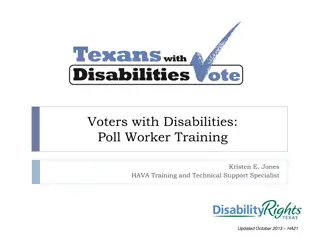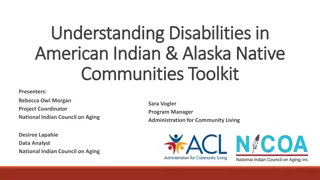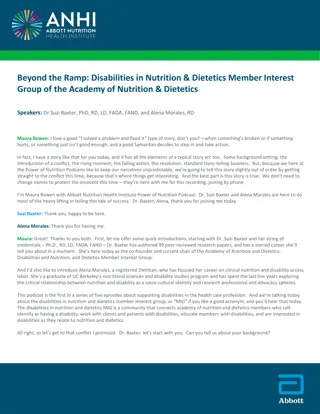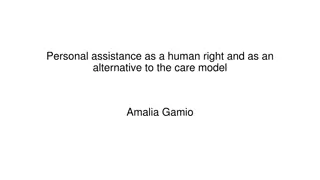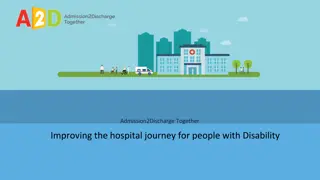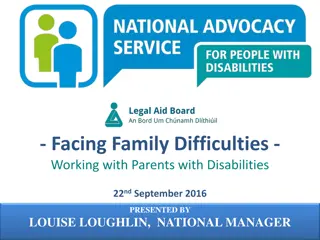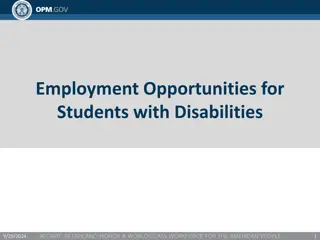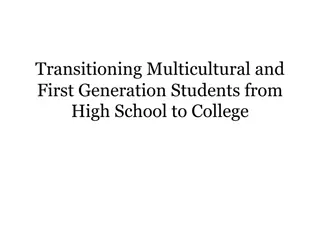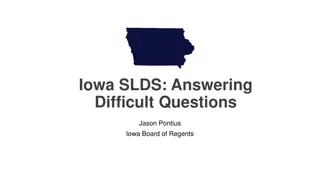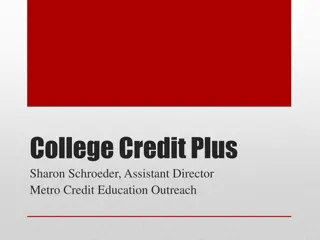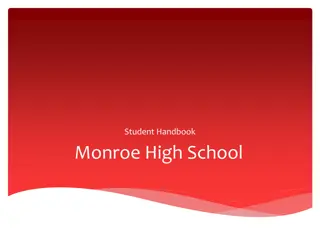Transitioning from High School to College with Disabilities
Explore the transition process from high school to college for students with disabilities, including Individualized Education Plans (IEPs) under IDEA, 504 Plans, differences in services between high school and college, and the historical background of the Americans with Disabilities Act (ADA).
Uploaded on Sep 29, 2024 | 0 Views
Download Presentation

Please find below an Image/Link to download the presentation.
The content on the website is provided AS IS for your information and personal use only. It may not be sold, licensed, or shared on other websites without obtaining consent from the author. Download presentation by click this link. If you encounter any issues during the download, it is possible that the publisher has removed the file from their server.
E N D
Presentation Transcript
High School to College Transition for students with disability
IEP Plans A result of The Individuals with Disabilities Education Act (IDEA) of 1975. A federal education law. Addresses the educational needs of children with disabilities from birth to the age of 21. Provision of services is through special education. Mandates a Free Appropriate Public Education (FAPE) in the Least Restrictive Environment (LRE).
504 Plans A result of Section 504 of the Rehabilitation Act of 1973. Programs and activities are available to all individuals with disabilities in programs receiving federal funds. Individual qualifies for disabled status when a condition limits a major life activity. Provision of services is through regular education as reasonable accommodations or modifications. A civil rights law, so broader than IDEA.
Both 504s and IEPs Both require provision of free appropriate public education, eligibility of services, procedural safeguards, evaluations and individual education services. If qualify for IEP under IDEA, also protected by 504. If qualify for 504, do not necessarily qualify for IEP.
ADA Historical Background of the ADA Original Act signed into law by President George H.W. Bush on July 26, 1990. Title I of the ADA of 1990 prohibits private employers, state and local governments, employment agencies and labor unions from discriminating against qualified individuals with disabilities in job application procedures, hiring, firing, advancement, compensation, job training, and other terms, conditions, and privileges of employment. On September 25, 2008, President Bush signed into law the ADA Amendments Act of 2008 Restore Congress s original intent that the ADA provide broad protections against discrimination based upon disability
Comparison of Disabilities Services High School and College College Services: High School Services: Services are driven only by civil rights laws. Services are driven by education and civil rights laws. Equal Access to education is stressed. No one is entitled to services, but students have civil rights and must advocate for themselves. Students with disabilities are entitled to a Free and Appropriate Public Education under IDEA. Education laws require secondary schools to provide services that ensure academic success. IEP mandates and special education services end with high school graduation.
Comparison of Disabilities Services High School and College High School Services: College Services: IEP drives all services and accommodations, and involves teachers and counselors. No formal plan. Students contact DSS and instructors regarding their needs. Parents only receive information upon student s written permission. IEP requires parent signature. Students must meet all entrance and academic requirements, even if they receive accommodations. Appropriate age and disability qualifies students for public education.
Comparison of Disabilities Services High School and College High School Services: College Services: Student provides proof of disability within accepted guidelines. Public schools are responsible for appropriate assessment of student s disability. Waivers for requirements rarely granted. May grant substitutions after adequate verification and unsuccessful attempt at requested course. Some subjects may be waived for high school graduation if specifically related to disability. (High school waivers may restrict admissions eligibility.)
Comparison of Disabilities Services High School and College High School Services: College Services: Un-timed tests are not allowed. However time extensions may be granted. Students may be allowed to take un-timed tests in light of their disability. Students may receive accommodations such as shortening of assignments or use of notes on tests. No accommodations are permitted that reduce the standard for any student. Student secures own services independently. Assessments, therapies and personal care provided by the school.
Comparison of Disabilities Services High School and College High School Services: College Services: Integration assumed and expected, with reasonable environmental accommodations. Least restrictive environment for learning determined by team.
Its been our experience that students with learning disabilities who acknowledge the existence of a disability and seek assistance early are more likely to achieve success than those who wait for problems to develop. M. Barron, Director of Admissions, University of Iowa Kravets, M. & Wax, I. (2005) The K & W Guide to Colleges for Students with Learning Disabilities or Attention Deficit Disorder (8th ed.)..
Before going to college, students need to know who they are and what they ll need to succeed. Jaci, Freshman, University North Carolina as critically important life skills for students with LD/ADD to develop before heading off to college. Self-Awareness and the development of advocacy skills have long been reported Kravets, M. & Wax, I. (2005) The K & W Guide to Colleges for Students with Learning Disabilities or Attention Deficit Disorder (8th ed.)..
What Parents Can Do to Help Develop These Skills Anticipate times of confusion, concern and frustration. Identify resources to assist you with the understanding and acceptance of your teen s disability. Get curious with your teenager they are experts on themselves. Explore with students their strengths, academically and non-academically, and encourage further expansion of areas enjoyed. Identify your feelings about the use of medication and know its potential. Notice when and where you manage your teen s life and begin to relinquish these responsibilities to your teen. Expand teen s areas of responsibility academically and non-academically. Kravets, M. & Wax, I. (2005) The K & W Guide to Colleges for Students with Learning Disabilities or Attention Deficit Disorder (8th ed.)..
What Parents Can Do to Help Your Student Develop These Skills Develop an understanding of how students feel about medication to ensure their continued use once leaving home. Explore with students their views about the disability. How they view it socially, emotionally and academically. Keep the student centrally involved in decisions about their educational plan, current accommodations and their future plans. Help student identify professionals within the community who can provide information to develop skills needed for their transition. Encourage student to build a high school schedule that is as challenging as possible without being overwhelming. Train students to get actively involved with their IEPs. Kravets, M. & Wax, I. (2005) The K & W Guide to Colleges for Students with Learning Disabilities or Attention Deficit Disorder (8th ed.)..
Documentation Purpose To establish that the student has a disability as defined by Section 504 and the ADA. It guides the college in providing appropriate accommodations. Requirements Documentation must indicate that the disability substantially limits one or more major life activity, including learning. Requirements may vary by colleges, but the more comprehensive the better.
Accommodations Colleges seek to provide effective accommodations rather than all recommended accommodations. Common Accommodations Reduced course load Extended time to complete tests and assignments Extended time to complete degree requirements A note-taker A course substitution of nonessential courses Quiet testing room Books on tape The right to record classes Alternate test-taking format sometimes It s up to the student to self-advocate for implementation of accommodations. ETS, (2007). Policy Statement for Documentation of a Learning Disability In Adolescents and Adults, (2nd ed.).
The good news is that the number of students succeeding in college who have learning disabilities and/or attention deficit disorders are equally good as the number of students without learning disabilities and/or attention deficit disorders! Jane Benson, Director of Learning Disabilities Services, University of North Carolina Kravets, M. & Wax, I. (2005) The K & W Guide to Colleges for Students with Learning Disabilities or Attention Deficit Disorder (8th ed.)..



